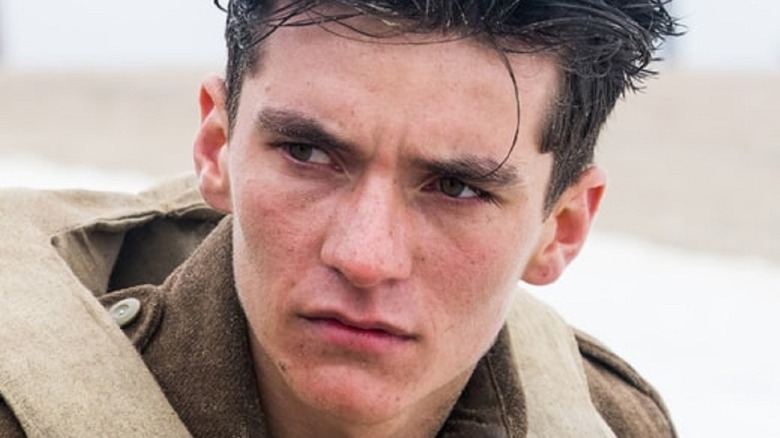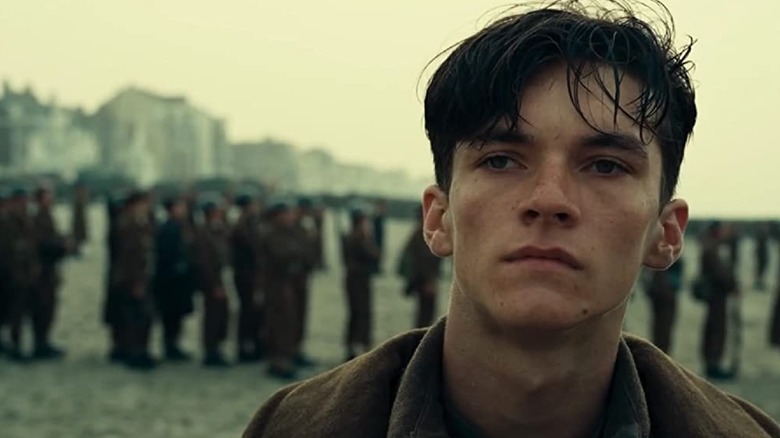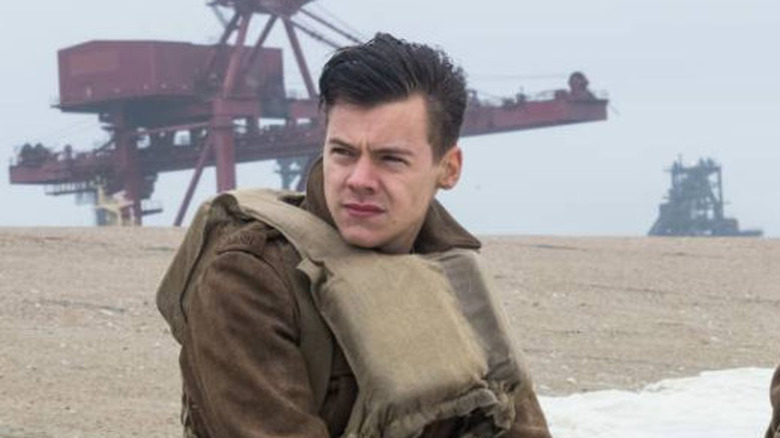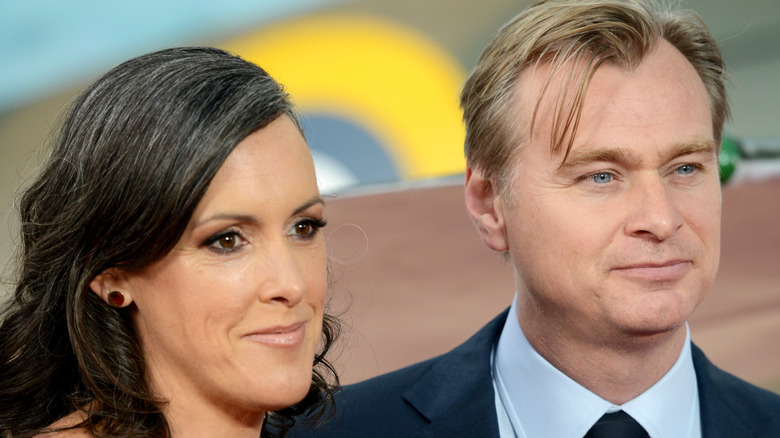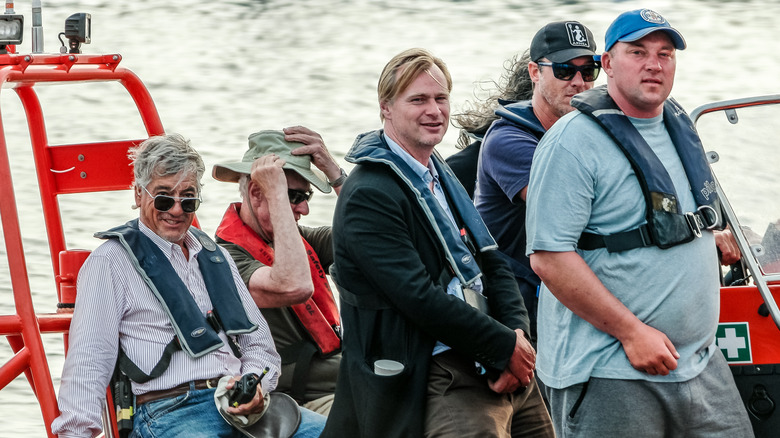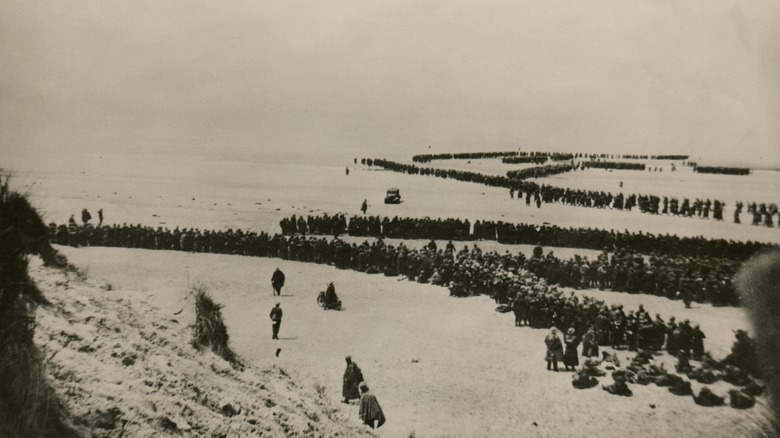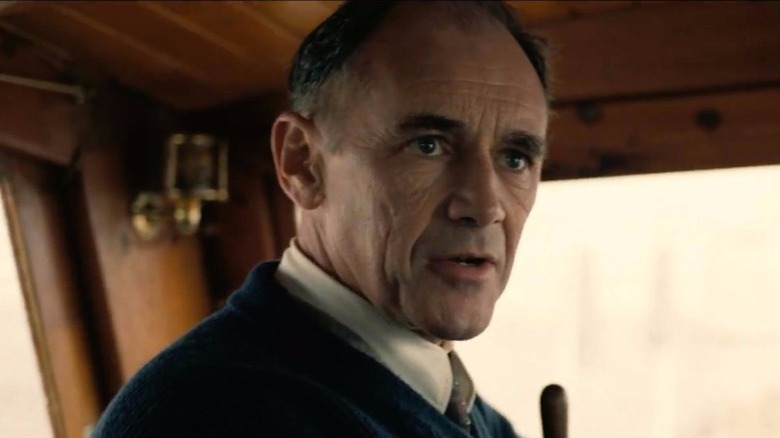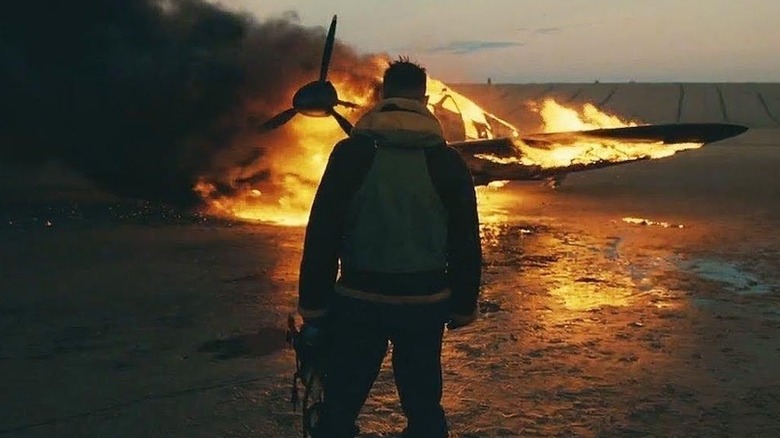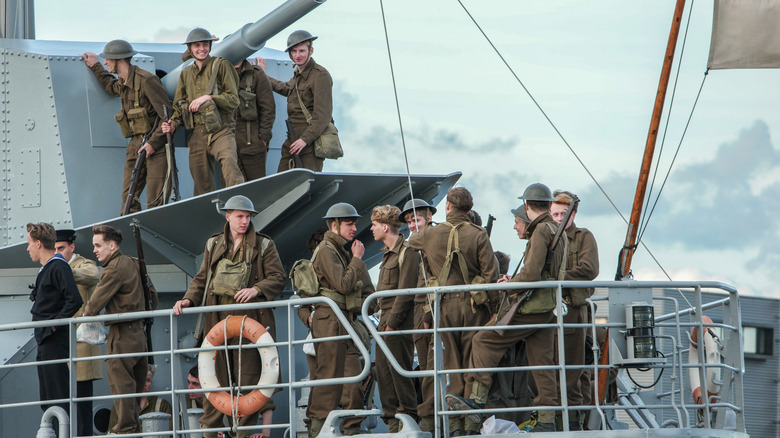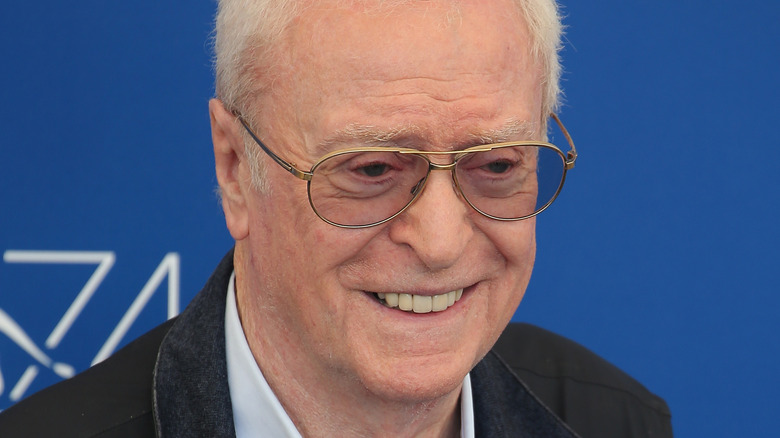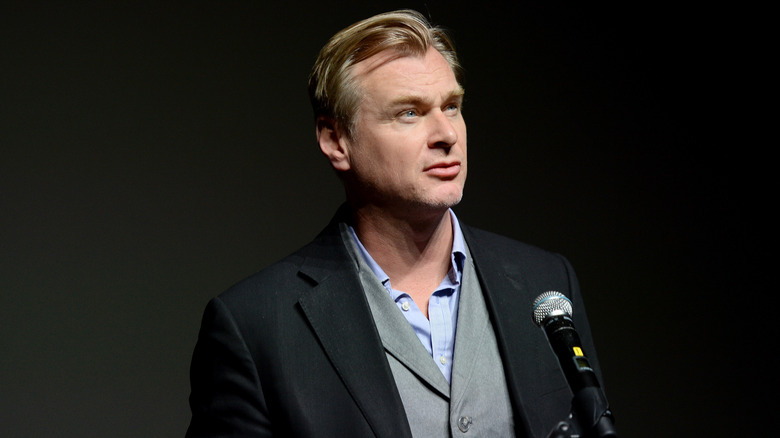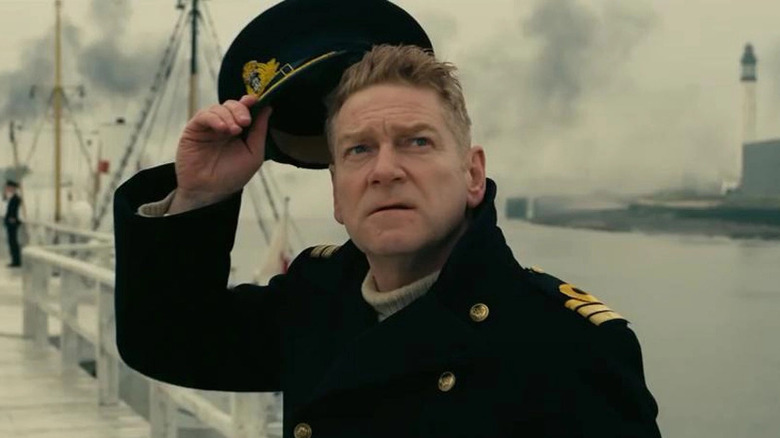The Untold Truth Of Dunkirk
Even by Christopher Nolan's standards, "Dunkirk" is one of the director's most exceptional films. Relying on an unorthodox narrative format, innovative use of time, and more practical filmmaking techniques, it's a taut, wonderfully paced, nightmarish look at the chaotic Allied evacuation of France in the early days of World War II.
Combining a booming score by Hans Zimmer, minimal dialogue, and a mixture of established and up-and-coming actors, it's a war film unlike any other, offering a frightening glimpse at a historic moment in global history when the Allies came dangerously close to losing World War II. As ambitious a film as any Nolan has made over the years, "Dunkirk" was a massive financial success at the time of its release in 2017, drawing in universally acclaimed reviews from critics. Among its numerous accolades, it earned a total of eight Academy Award nominations, including Best Picture and Best Director.
Breaking numerous rules when it comes to larger-budgeted war films, "Dunkirk" is also one of the most unconventional films ever made by Nolan. It's a movie that required the director to use a plethora of unique methods to craft a wholly original cinematic experience for audience members. With how experimental "Dunkirk" was, there are likely some subtle details about the film that most viewers don't know, which illustrate Nolan's commitment to creating the perfect WW2 film. Here are some of the more interesting behind-the-scenes facts about "Dunkirk."
The idea came to Christopher Nolan on vacation
The original idea for "Dunkirk" came to Christopher Nolan while on vacation with his wife, producer Emma Thomas. In an interview with The New York Times, Nolan discussed a 1992 trip he shared with Thomas, with he and Thomas boarding a friend's small yacht and crossing the English Channel from Great Britain to Dunkirk, retracing some of the routes taken by actual Dunkirk survivors.
The couple believed the voyage would fill up perhaps a morning and afternoon, but the turbulent condition of the sea and the prevailing winds took a toll on their crossing, with the entire trip taking a grueling 19 hours. "It was a very intense experience, and no one was dropping bombs on us," Nolan told The Times. "I think that really planted the seeds for me."
Recognizing the concept was an ambitious one for a then-unknown director, Nolan held onto the idea as he established himself in Hollywood. Knowing he'd need a bigger budget to work on a film as large as "Dunkirk," Nolan approached Warner Bros. with his idea for the film after he'd become more widely known as a director. Based on the critical and financial success of the "Dark Knight" trilogy, the studio ultimately agreed to support the film's production.
Young unknown actors were specifically chosen for the film
Early in the production process of "Dunkirk," Christopher Nolan carefully researched the actual Dunkirk evacuation to ensure the film was as authentic and true to life as possible. Reading excerpts from survivors' accounts of the evacuation, Nolan was struck by how young many of the English soldiers were at the time of the battle. Because of this, Nolan resolved to cast mostly younger, unknown actors as the movie's British soldiers, especially in the case of up-and-coming actor Fionn Whitehead, who stars in the film.
"One of the key things you came across, reading first-hand accounts of Dunkirk, was how young and inexperienced these soldiers were," Nolan told Entertainment Weekly. "It felt very important to me, especially for Fionn's part, to find somebody very new." In the film's behind-the-scenes documentary featurette, "The Dunkirk Spirit," Nolan said he was adamant about casting younger actors to provide a layer of authenticity in his presentation of World War II. "We were very determined to try and be true to the actual reality of what happened there ... Some of them were really just kids," said Nolan.
The added sense of realism helped the film greatly, as opined by casting director John Papsidera in the featurette. "We were really talking about 17, 18, 19-year-old actors. You start exploding things around them, and you're going to get very real reactions," he said.
Nolan was unfamiliar with Harry Styles prior to his casting
One of the few recognizable faces that stand out in "Dunkirk" is that of world-famous musician Harry Styles. Knowing Nolan specifically sought out lesser-known actors for the film, it may seem a bit odd to see Styles in the movie. The obvious assumption is that Nolan cast the English pop star based on his celebrity status. However, Nolan has said that wasn't the case, and that he didn't actually realize until later who Styles was when he initially brought him onto the film.
According to The New Zealand Herald, Nolan said that the decision to cast Styles in the film was mainly due to Styles' "old-fashioned" face. As Nolan put it, Styles had "the kind of face that makes you believe he could have been alive in that period. Harry's character's very un-glamorous. It's not a showboating role." Only later did Nolan learn how well-known a star Styles was, telling The Hollywood Reporter that during the casting process, "I don't think I was that aware really of how famous Harry was."
After learning of Styles' extensive celebrity status, Nolan still decided to include the singer in his film, basing his decision more on Styles' performance than his fame. "I cast Harry because he fit the part wonderfully and truly earned a seat at the table," Nolan told The Hollywood Reporter. Nolan later defended his decision, telling Vanity Fair, "I auditioned literally thousands of young men with different combinations of young men. And he had it."
Nolan originally wanted to improvise the entire film
"Dunkirk" is known for its sparse use of dialogue to carry the narrative forward, relying more on visual storytelling to guide the film's action (with Nolan using silent films as a key source of inspiration). Such minimal use of dialogue was an intentional creative choice made by Nolan, serving as a stylistic departure from his previous, more exposition-heavy films (via The Hollywood Reporter).
As he embarked on researching the history surrounding "Dunkirk," Nolan flirted with the idea of not even using a script to hold the movie together, believing he was familiar enough with the subject to paint an interesting portrait of the evacuation. "I got to a point where I understood the scope and movement and the history of what I wanted the film to address, because it's very simple geography," Nolan explained. "I said, 'I don't want a script. Because I just want to show it,' it's almost like I want to just stage it. And film it."
When Nolan brought the idea of a script-free film to his wife and producer, Emma Thomas, Thomas quickly convinced him otherwise. By traditional films' standards, though, the script for "Dunkirk" is still incredibly thin, coming in at a scant 76 pages. It's one of Nolan's shortest scripts and films to date, with Nolan claiming that he wrote the screenplay in a relatively short period of time after mapping out the three separate storylines.
Nolan hoped to make an inverted WW2 movie
One of the main things that intrigued Nolan about the story of "Dunkirk" was the fact that it flipped or inverted the usual Hollywood formula of World War II films. Nolan cited the fact that his main point of interest was that — unlike most WW2 films — the Dunkirk evacuation was not an Allied victory, nor did it involve any American soldiers (the US wouldn't enter the war until the tail end of 1941).
Because of this, Nolan strove for making more of a suspense thriller than a traditional war movie, focusing more on the individual perspectives of the soldiers rather than any dramatized or overly-sentimental portrayal of historical events. "I wanted to tell the story in as objective a way as possible and trust that the facts of it would inspire an emotional response. We tried not to be overtly emotionally manipulative," Nolan told IndieWire.
For authenticity's sake, Nolan also opted to avoid using American or older actors to play the predominantly younger British cast. Nolan mentioned that the concept was a hard sell for studio executives, but they eventually conceded after more well-known actors like Tom Hardy and Kenneth Branagh were brought onto the film in supporting roles.
The film was praised by actual Dunkirk veterans
The release of "Dunkirk" was met with overwhelmingly positive reviews from critics, some of whom went on to name it one of the greatest war films of all time. Perhaps even more meaningful than the film's positive reception among film critics was the praise heaped onto it by actual World War II veterans, including those who served at Dunkirk and experienced the evacuation firsthand.
In some cases, Dunkirk veterans like 97-year-old Ken Sturdy — who was just 20 years old in 1940 — was left in tears by the authenticity of the film. "I never thought I would see that again. It was just like I was there again," Sturdy told Global News. Another veteran, 96-year-old George Wagner, also commended the film. "The whole thing was really realistic ... when I saw the film, I was brought back," Wagner told People magazine.
Speaking on The Late Show with Stephen Colbert, actor Kenneth Branagh shared similar stories about veterans who attended the premiere of the film. According to Branagh, these veterans also pointed out that the movie was louder than the real event — a critique that apparently amused Christoper Nolan. "I said 'What did you think of the film?' They said the film was louder than the battle, which I think really, really tickled Chris Nolan," Branagh told Colbert with a chuckle.
Mark Rylance's character is based on a Titanic survivor
In the film, Mark Rylance portrays Mr. Dawson, one of the many British civilian sailors who volunteered his ship to ferry troops from the beaches of Dunkirk to the English coast. Rather than letting the Royal Navy requisition his vessel, Dawson pilots the ship himself to Dunkirk, aided only by his son (Tom Glynn-Carney) and their teenage hand (Barry Keoghan). While the characters in the film are fictional, they are closely based on real civilians who aided in the Dunkirk evacuation — with Rylance's Dawson standing in for Charles Lightoller, a naval veteran and officer who served on the Titanic.
In 1912, Lightoller embarked on the Titanic for the ship's maiden voyage. When the ship struck an iceberg in the Atlantic Ocean, Lightoller stayed at his post, guiding numerous passengers to the few lifeboats and strictly adhering to the ship's "women and children first" protocol. Narrowly avoiding drowning in the wreckage of the Titanic, Lightoller and a handful of survivors managed to stay afloat on an overturned lifeboat before being rescued.
Later, the Royal Navy placed him in command of a torpedo boat during World War I, with Lightoller earning the Distinguished Service Cross for his wartime efforts. During the Dunkirk evacuation, the retired Lightoller captained his private ship, the Sundowner, to France with his oldest son and a teenage Sea Scout. While the ship itself had only ever fit a maximum of 21 passengers, Lightoller took a total of 130 British soldiers aboard, returning them home to England.
Tom Hardy's character shares the story of a real WW2 pilot
Mark Rylance's character isn't the only historical personage that was included in "Dunkirk." Another of the film's main stars was Tom Hardy, who played the skilled RAF Spitfire pilot, Farrier. Since the film's release, several publications have noted similarities between Hardy's character in the movie and a real World War II New Zealand veteran named Christopher "Al" Deere. Like Hardy's Farrier, Deere was an RAF Spitfire pilot who fought over the beaches of Dunkirk, fending off the defenseless soldiers below from incoming German bombers.
After flying over Dunkirk and combating German aircraft for days (shooting down a total of six enemy planes), Deere's plane was shot down, the 22-year-old managing to make a careful landing at a Belgian beach (not unlike Hardy's miraculous landing at the end of the film). Unlike Hardy's Farrier, though, who finds himself captured by German forces at the movie's conclusion, Deere managed to venture back to the beaches of Dunkirk, joining the line of British soldiers there waiting to be ferried across the Channel.
The parallels between Farrier and Deere may be coincidental, but the similarities between the two are hard to ignore, with Deere's own family noting the shared resemblance. "The arc of Tom Hardy's character does closely echo Al," Deere's nephew, Brendon Deere, told The New Zealand Herald. "His characteristics as well — the steely resolve and determination to get the job done — are pretty typical of what I saw in my uncle."
Nolan relied heavily on practical effects
Christopher Nolan does his best in each of his films to avoid the use of CGI, feeling digital effects should be only used to make pre-existing material better. "However sophisticated your computer-generated imagery is, if it's been created from no physical elements and you haven't shot anything, it's going to feel like animation," Nolan once explained in a Directors Guild of America interview.
With his hard stance on CGI, Nolan routinely relies on practical effects in almost of his films. "Dunkirk" is no exception to this, with Nolan making use of numerous special effects to achieve his creative vision. When it came to filming the larger crowd scenes showing English troops awaiting transportation on the beaches, Nolan used upwards of 1,500 background extras (via The Daily Telegraph). However, that number still didn't come close to matching the 333,000 Allied soldiers at Dunkirk during the actual evacuation. To compensate for this, Nolan filled in the background with cardboard cut-outs of soldiers and vehicles to give the illusion of depth.
Nolan similarly attempted to use a mixture of authentic ships and aircraft for added realism. The decommissioned French Navy Destroyer, the Maillé-Brézé, was used for scenes showing Royal Naval vessels, with as many as 60 other actual ships shown in some scenes (per The Independent). As reported by Smithsonian Magazine, Nolan also used several planes that were repainted to look like period accurate aircraft for the time, such as the Soviet Yak-52, which provided interior shots for a British Spitfire.
Blink-and-you'll-miss-it cameos
"Dunkirk" sees Nolan reunite with several frequent collaborators he's worked with on past films. These include composer Hans Zimmer, who Nolan's worked with since 2005's "Batman Begins," as well as recurring actors like Tom Hardy and Cillian Murphy. Upon first viewing, more hardcore Nolan fans might notice the absence of Nolan's foremost collaborator, Michael Caine, who's appeared in every one of Nolan's films since "Batman Begins." However, those with more adept hearing might be able to spot Michael Caine's uncredited vocal cameo near the beginning of the movie.
Caine's cameo comes early in "Dunkirk," with the veteran British actor playing the off-screen character of Fortis Leader, the leader of the three RAF Spitfires that play a huge role in the film. Likely due to the actor's age, Caine's performance in "Dunkirk" is voice-only, but it's still impressive to see Nolan include one of his most faithful collaborators in the film.
Additionally, Nolan inserts another small cameo near the movie's conclusion. As Gibson and his fellow soldiers arrive in England, they are greeted by an elderly blind man handing out blankets to the young men, telling them all, "Well done." This character is played by John Nolan, Christopher Nolan's paternal uncle, who's appeared in several of his nephew's films, notably playing a Wayne Enterprises board member in "Batman Begins" and "The Dark Knight Rises."
Nolan placed a lot of emphasis on sound design
With its minimal use of dialogue, Nolan placed a heavy emphasis on visuals and sound design to convey much of the movie's story. Recognizing the importance of using sound to his advantage from an artistic perspective, Nolan had the inspired idea to use a musical illusion known as Shepard Tone in the film's background.
In essence, a Shepard Tone is a technique wherein a musician overlaps notes one octave higher or lower than the original note, creating an impression of a continuous, never-ending rising or falling score. Because of its ability to create a sense of anxiety or suspense with the gradually building notes, Nolan had used Shepard Tone for the soundtrack of his earlier thriller film, "The Prestige," as he told Business Insider. When it came time to film "Dunkirk," Nolan once again looked to utilize a Shepard Tone for the soundtrack, even using it as an artistic inspiration for the layout of the movie's connected storylines.
"I interwove the three timelines in such a way that there's a continual feeling of intensity. Increasing intensity," said Nolan. "So there's a fusion of music and sound effects and picture that we've never been able to achieve before."
Nolan's own watch appears in the film's soundtrack
As mentioned above, Christopher Nolan placed a key emphasis on the film's soundtrack and background score. Reuniting with regular composer Hans Zimmer, Nolan tried to create a cohesive cinematic experience that combined as many senses as possible. Seeking inspiration wherever they could find it, Nolan and Zimmer had one idea for the soundtrack that originally came from a particular ticking noise made by Nolan's personal pocket watch — a noise that later found its way into the film.
Nolan explained to Business Insider, "Very early on I sent Hans a recording that I made of a watch that I own with a particularly insistent ticking, and we started to build the track out of that sound and then working from that sound we built the music as we built the picture cut." From there, Zimmer discussed with Nolan potential directions the soundtrack could take, working tirelessly at coming up with a score the two were mutually content with.
"'Dunkirk' was the hardest thing we ever did. I demoed up a 100-minute piece that became a grid of tension," Zimmer told Gold Derby. After months of working, the director and composer had a soundtrack they both found unique and satisfactory, which paired well with the movie's visuals. "We've managed to create a new experience, making it a whole experience, where the sound, the music and the visuals are of one storytelling experience," Zimmer said.
Dunkirk was one of the few 70mm films of its decade
Given his high ambitions for the film, Christopher Nolan set out to create a cinematic experience that was entirely singular. To accomplish this, he chose to shoot the movie primarily in IMAX 65mm as opposed to the more commonly-used digital footage captured for most films today (via Variety). In the past, Nolan has showed a preference for using IMAX and traditional film over digital, with "Dunkirk" containing more IMAX footage than any other movie in Nolan's career up that point, as the director revealed to Fandango.
As digital film has become the norm in the movie industry, "Dunkirk" is noteworthy in that it is one of only a few films that received a limited 70mm release in the 2010s. The other two films that saw limited releases before "Dunkirk" were Paul Thomas Anderson's psychological drama, "The Master," and Quentin Tarantino's spaghetti Western mystery film, "The Hateful Eight" (via Deadline). Another film shot in 65mm and released in 70mm was "Murder on the Orient Express" — coincidentally directed by "Dunkirk" actor Kenneth Branagh and released the same year as Nolan's film, although "Murder on the Orient Express" received a much smaller 70mm release than "Dunkirk."
